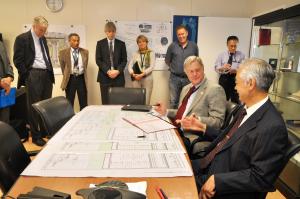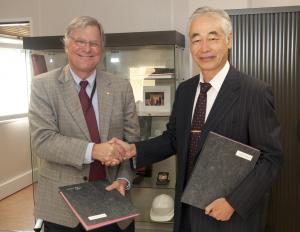On the inside of the ITER vacuum vessel where extreme temperatures reign, the attraction between electrons and their nuclei is overcome and gas becomes a plasma—the hot, electrically charged environment that is the breeding ground for fusion reactions.
The reverse phenomenon is produced at the edge of the plasma: the ions lose their electrical charge as they come into contact with the material surfaces of the vessel and a neutral gas is formed between the vessel walls and the edge of the plasma.
Sampling this edge gas to decipher its exact composition—both at the machine's mid-level and at the divertor level where exhaust is pumped out—will furnish ITER operators with important information about the plasma and plasma-wall interactions.
Responsibility for sampling and analyzing the composition of neutral gases during operation will fall upon two residual gas analyzers (RGAs) in ITER. The Procurement Arrangement for these diagnostics was signed last Friday, September 23 by Director-General Osamu Motojima and US ITER Project Manager, Ned Sauthoff.
The RGA diagnostic systems will be installed in shielded environments away from the intense magnetic field and the neutron emission of the ITER machine. Neutral gas sampled at the level of the equatorial port plug or divertor pumping duct will be transported through long pipes (up to 14 metres) to be analyzed under controlled conditions. "By continuously identifying the neutral gas composition in the main chamber and in the divertor exhaust," explains Philip Andrew, ITER's Technical Responsible Officer for the RGA Procurement Arrangement, "operators will have information on the efficiency of the divertor in removing helium from the plasma. Helium is the natural byproduct of the fusion reactions, but if allowed to accumulate in the plasma, it displaces the deuterium and tritium fuel and reduces the fusion reaction rate."



